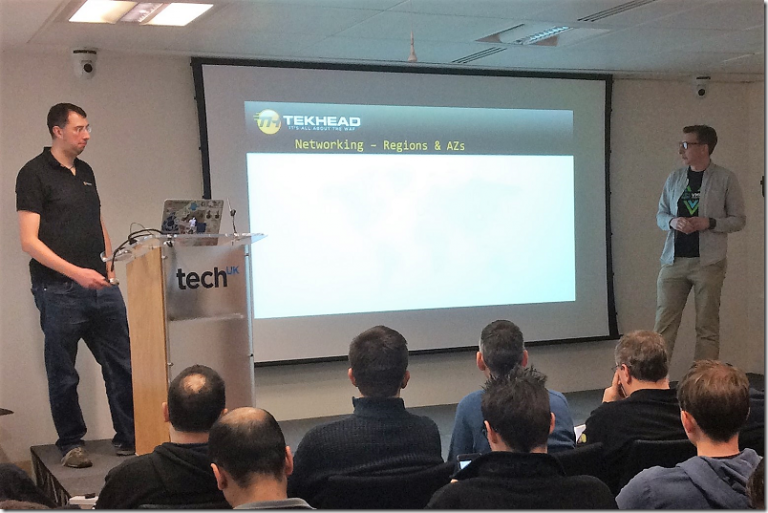VMUG London January 2017
Last week saw the first London VMware User Group of the year, another great meetup with many of the usual faces along with some new ones. This was another informative event at the TechUK site just off Fleet Street, and was again very community orientated. If you want to go and find out how people are using VMware products (and others in the surrounding ecosystem) then I’d thoroughly recommend these events- there’s just the right balance between real technical accounts direct from the coalface and marketing of new and interesting products
Rubrik
After introductions the sessions were kicked off with sponsors Rubrik showcasing their data protection tools and how they scale to support a virtual environment. It’s an impressive setup- Rubrik nodes within an organisation take policy driven backups of the virtual environment, their differentiator is the ability to spin up backups for test/DR purposes direct from the node- making restores almost instant. Entire VMs or individual files,SQL Tables, or exchange mailboxes can be live mounted from the device without the need for a separate restore step first. The on-premises nodes can be backed by AWS/Azure cloud storage for long term retention purposes.
vSphere 6.5 What’s new, what’s cool
Next up was Paul Nothard from VMware to talk through the new features of the latest vSphere. In true “Top Gear” styleee, Paul (and his glamorous assistant) used a Cool Wall to allow the audience to rate some of the new additions. Unsurprisingly, most of the features landed down the “Cool”/”Seriously Cool” end of the board- built-in vCenter Server Appliance HA, Encrypted VMs and vMotion, improvements in the VCSA monitoring capabilities, and good migration from earlier versions of vSphere for example. I do feel that some of the new features are perhaps only considered cool because of the uncool designs in some of their predecessors- the HTML5 client is cool because of the much-maligned Flash client it replaces, and the integrated VUM in vCenter Server Appliances is great but possibly it’s coolness is heightened by the awkward situation before where VUM required a separate Windows server.
An Admins Guide to AWS
A packed house saw the first community session of the day where Chris Porter and Alex Galbraith took the stage to give us an introduction to AWS. The pair covered all the fundamentals of the cloud architecture- from setting your account up (top tip- remember to enable MFA!) through to the networking, storage, and compute offerings. They also highlighted some of the different thinking required when deploying an application to AWS rather than an on-premises vSphere environment- using load balancing as vMotion is not available for example, and taking advantage of the incredible scaling abilities the worlds biggest public cloud offers.

StorMagic
After lunch I attended the second sponsor session, this time from StorMagic- talking about software defined storage and where their SvSAN product sits in the maturing hyperconverged marketplace. SvSAN sits as a Virtual Storage Appliance on 2 or more nodes (with a remote witness to avoid Split-Brain problems) within a Virtual Environment. Their take is that compared to VMware’s vSAN which sits in the hypervisor, the VSA approach allows more flexibility on storage and can even be hypervisor agnostic. StorMagic highlight their ability to measure storage needs and therefore size a storage solution close to the customers needs- meeting the demands but minimising wastage by playing to the strengths of each storage medium available.
PaaS
For my final session I chose Ricky El-Qasem’s PaaS marathon. Ricky guided us through the basics of microservices, Pivotal Cloud Foundry, 12-factor Cloud Native apps. He told us how PaaS was coming out of it’s niche and into the mainstream. The architecture of cloud native apps is API-driven and designed around scalability, not storing data locally (and hard-coded UNC paths to Access databases are now frowned upon :) ), and microservices each doing a small task and capable of working independently of each other. Of the analogies used, the one that fit best for me was being able to fix/replace/upgrade a single carriage (microservice) on a train (application), rather than the entire train.
Ricky has also prepared a quick install guide for anyone who wants to try out CloudFoundry in their lab- PCF-Quick-Install-Guide-1.pdf
Thanks
Thanks to the sponsors Rubrik, iland, and StorMagic, and in particular to the London VMUG Committee who volunteer their time to put these events on. The next London VMUG will be on the 6th April 2017.
